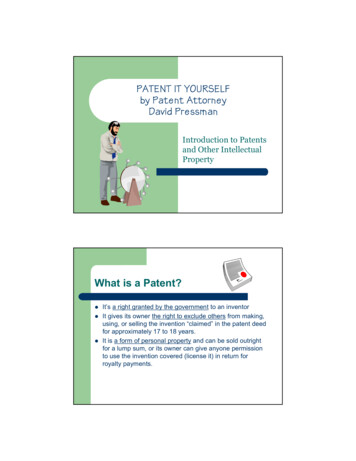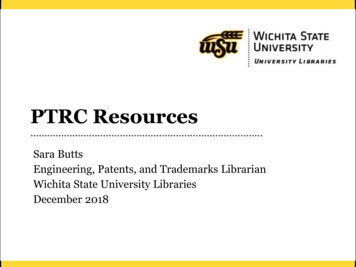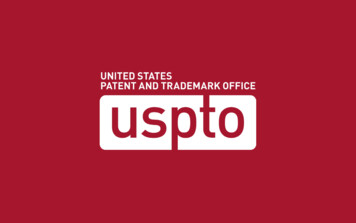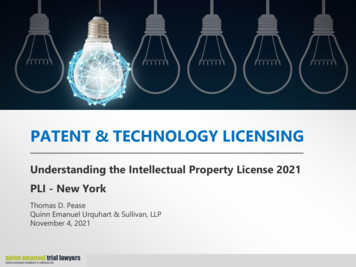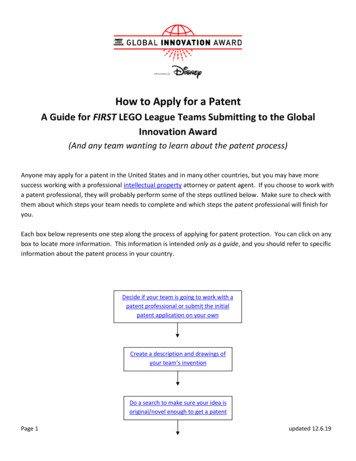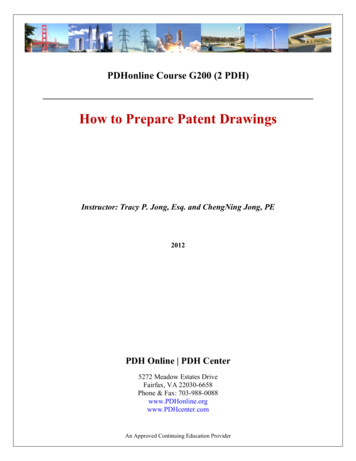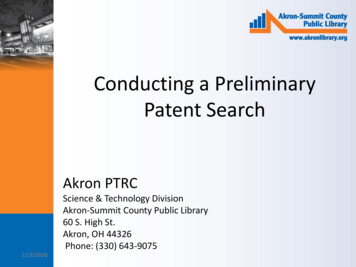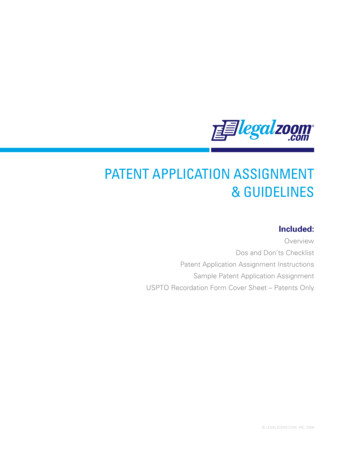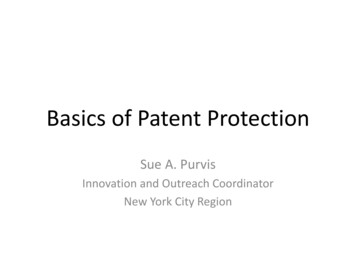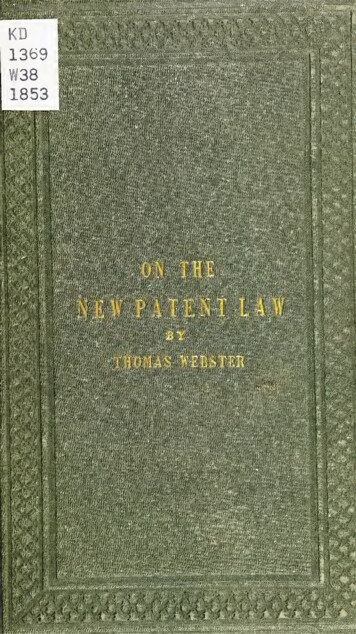
Transcription
kJ)1 53(llnrnpUHamiri nol ICibrary
Cornell University LibraryKD 1369.W38 1853The new patent law:its3 1924 021history obects862 440
Cornell UniversityLibraryThetineoriginal oftliisbookis inCornell University Library.There are no known copyrightrestrictions inthe United States on the use of 62440
.TI-IENEW PATENTLAW:ITSHISTORY, OBJECTS,AND PROVISIONS:IHE14Vict.c.8i &15Vict.c.6;AND fi« nUnt15& mmtsmmtUnit)16 Vict.83,c.&16 Vict.o.5' ct ,;THERULES OF THE COMMISSIONERS OF PATENTS,AS REVISED TO APRIL,1853,ANDPRACTICAL FORMS AND PROCEEDINGS.THIRD EDITION.BYTHOMAS WEBSTER,-.Esq., M.A., F.R.S.,BARRISTER- AT-LAW.iv,-LONDON:F.ELSWORTH,19,CHANCERY LANE.1853.y-Iy
LONDONPBINTED BYA.:SWEETINO, EARTLEIT's BUILMNGS.
CONTENTS.
INTRODUCTION.Thefollowing pages are designed as aManualforInventorsdesirous of availing themselves of the provisions of thenewPatent Law; they will also serve as a guide in the furtherform of our patent system.TheStatutes, portions oftions, are sixteen inaffectedmaywhichrelate to patents for inven-number ; mostby " The Patentof these are superseded orLaw Amendment Act,consequently be regarded as theconsolidation of theThe experiencere-first1852," whichstep towards theLaw and Practice of Patents for Inventions.of six months' working of the patent systemhas disclosed the necessity of various alterations, in additionto the " omitted objects" adverted to in the following pages.Many of the provisional specifications are extremely meagre,and obviously framed with the view of concealment ratherthan ofThefairly disclosing the invention.provisional specifications have hitherto been treated asdocuments until after the filing of the complete speciand inventors are advised by some professional per;sons to place no reliance on the provisional protection,- but tosecretficationproceed at once for the patent. Inventors adopting such adviceabandon the benefit to be derived from the use and publicationof the invention during the period of provisional protection,and incur at once and withoutpatent and specification.The inadequacytrialthe whole expenses of theof the provisional specificationsas one reason for advice so contrary to thenew system;wholeisallegedspirit of theand the practice under the old system, wherebythe mere possession and knowledge of the invention by anopponent wasapplicant,isprinciple of thefirstallowedassumednewtostill toprevailin opposition to a priorprevail, in utter disregard of thesystem, that creditapplicant, except in cases of fraud;is toandbe given to thetowhich prin-
VIINTRODUCTION.ciple full effect is givenby the Lord Chancellor and thewhich have occurred.LawOfficers in the cases of oppositionIf the Rules of the Commissioners as to the provisional spe-were fully carried out, and the provisional specificawere open to inspection after its sufficiency had beencertified, inventors would have the means not only of protecting themselves against the conflict which is constantly occurring between subsequent and preceding patents relating toinventions substantially the same, but also of avoiding expen-cificationtionsive future litigation.The Rules of the Commissioners as to the drawings accompanying specifications will be the subject of further revision, asit is impossible that the system of publication can be carried outunless some check be placed on the fihng of preposterous andextravagant drawings, embellished with all the colours of therainbow. This is one of the relics of the old system ; it servesfor a cloak to theabsence of distinct substantive invention andproper description in words.Aand a half inch to the foot is sufficientand elevation of machinery. The detailsscale of one or onefor the general planmay be to a larger scale, full size, or double size, oreven larger; but a large scale is seldom necessary (except insmall instruments), inasmuch as working drawings and patterns are invariably made before any machine is constructedThe mechanical drawings for some yearsin the workshop.past executed by Mr. Falkner, of Manchester, and by otherof partspersons, on stone and zinc, and the descriptionof Britishmachinery, to be found in the elaborate works pubHshed atthe expense of Foreign states and bodies, ought long ago tohave led to some rules, whereby (as suggested in the following pages, p. 32) all deposited drawings should be from a stoneupon the responsibility of the patentee.and regulations of the Commissioners now inand new editionsforce will be found in the following pagesof this work will be published, from time to time, as anychange in the practice may render necessary.or plate preparedTherules;2,PumpCourt, Temple,April, 1853.T.W.
THENEWPATENT LAW,Letterspatent for inventions, prior to the com- Threemencement of the new law, were granted according systems.to three distinct systems ; each of the three countries,England, Scotland, and Ireland, having its own peculiar practice for the creation of such exclusive privileges within that part of the United Kingdom ; theChannel Islands, Colonies and Plantations abroad wereusually included in the patent for England, thoughsometimes the subject of a distinct grant made according to the practice for that country. These threedistinct systems of England, Scotland, and Ireland,now superseded by one system for the United Kingdom under " The Patent Law Amendment Act,1852," have continued to subsist notwithstanding theunqualified condemnation of every disinterested per-son of any experience in the subject (a). For the lastquarter of a century men of science, inventors, andprofessional men more peculiarly engaged in patentbusiness, have laboured for the abolition of a viciousand the establishment of arational system of creat-ing and protecting property in inventions in the artsand manufactures ; but the inherent difficulty of thesubject, the conflicting opinions of reformers, a want(a) No language can convey any adequate idea of the general dissatisfactionand distrust which existed in referenceto this subject amongst men of science,persons holding or having held thehighest judicial situations, law officers,and every class of professional men. Ithas been represented that patent agents,and other professional men more immediately engaged in obtaining patents, inpreparing specifications, or in litigationthereon, and in advising on inventionsgenerally, veere opposed to reform in thepatent system such, however, is not thefact ; Mr. Wyatt, the editor of the " Kepertory," Mr. Newton, the e4itor of;B
THE HEW PATENT LAW.2of Sympathy on the part of the public with the compa-Failure of*rcform/ratively small class of scientificthe mistaken jealousy ofcauses, gavesomeand ingenious men,and othercapitalists,power and effect to the obstructivenessnumerous persons in the threeor opposition of thecountries directly or indirectly interested in the officialfees leviedunder the existing systems, and manyefforts either failed or producedwell-intentionedtemporary expedients of little value. The history ofthe growth of abuses in the patent system is cuiiousand instructive, counterparts of which may be foundin other branches of our jurisprudencestriking instance of a system trained:itpresents aand fostered byprivate interests, until the accumulationof abuseshad paved the way for the extinction of the wholesystem, and induced many persons well affected towardsinventors to doubt the policy of maintaining propertyin the productions of ingenuity in the artsfactures.Theof that systemisequally curious and instructive"The LondonJournal of Arts andSciences," Mr. Robertson, the projectorand editor of the "Mechanic's Magaline," and Mr. Barlow in the " PatentJournal," and others, have written andgiven evidence against the system duringThe testithe last quarter of a century.oi M.V, Newtonandof the late Mr.Robertson, two of the oldest and mostsuccessful patent agents, is supported byalmost every other patent agent and professional person examined before any ofthe Committees of 1829, 1848, or 1851.The Select Committee of the House ofCommons in 1829 examined twenty-fourwitnessespersons of the greatest expeHence in the practical and applied sciencesmony—and in patents, as Davies Gilbert, M.P.,John Taylor, Mark Isambard Brunei,Arthur Aikin, Samuel Clegg, Isaac Hawkins, J. .Millington, and A. H. Holdsworth, M.P.;also, persons profession-ally connected with patents, asCharles Few,W. Newton—and manu-history of the struggles for the refoimB. Rotch,W. H. Wyatt, J. Farey,andall of whom condemned theexisting svstem.T he Committee on theSignet and Privy Seal Offices, in 1848,;butW.received evidence from C. Barlow, F.Campin, W.Newton, J.C. Robertson, W.Spence, and B, Woodcroft, all professionalpersons of experience, in exposition andcondemnation of the abuses necessarilyincident to the existing systemseveralof the same witnesses, with many othersof great attainments and experience, gaveevidence to the same eflFect before the twoSelect Committees of the House of Lordson the Designs and Patent Bills in 1851.On those' last occasions the system wasdescribed as exhibiting "dodging" (482),"all sorts of manoeuvres understood byracing" (884), "giving advantage to anunscrupulous over a scrupulous agent, andpresenting a sort of strife degrading to beconnected with" (886); as affording nosecurity, and as bad as hoise jockeying(211}--(See evidence before SelectCommittee of House of Lords, 1851, onPatent and Designs Bills).Ihesu witnesses differed as to the nature and extent of the remedy to be applied, buiwere of accord as to the existence andcharacter of the disease.;
THE HISTORY.3would be foreign to our present purpose to dwellmore on this part of the subject than to present aitsimple record of the past as introductory to and explanatory of the new system.In 1829, a Select Committee of the House ofFormerCommons wasappointed to inquire into the state of ***«'"P* the law and practice relative to the granting of Patents *' ' 'for Indentions ; numerous witnesses were examined;the committee reported the evidence, and recommended the resumption of the inquiry early in thenext session. The inquiry was not resumed ; indeedlittle necessity existed for further inquiry ; the witnesses were almostunanimous in condemning the exsystem, and were agreed on many materialpoints as to the remedies to be applied ; the leadingistingfeatures ofwhich were the sameas of the systemnowsuperseded.In 1833 abill,introduced by the late Mr. Godson, a.d.Commons ; but arriving at the1833.passed the House ofHouseof Lords at a late period of the Session,further considerationwas postponeditsuntil the nextSession; the Marquis of Clanricarde, the Lord Chan-(Lord Brougham), Lord Wynford, and the LordChancellor of Ireland (Lord Plunket), speakingstrongly on the necessity and importance of the subcellorject.In 1835 abill,introduced by Lord Brougham, a.d.passed the House of Lords; the second reading wasHouse of Commons by Mr. W. Tookemembers expressed great regret at the measurenot being more comprehensive; the Lord Advocateand other members commented on the following evils1. The amount ofas untouched by the measure:2. The existence of distinctfees and expenses.3. Thepatents for England, Scotland, and Ireland.interval between the application and the grant, during which the applicant was without any protection,and subjected to opposition. The measure howevermovedin the:several—1835.
THE NEW PATENT LAW.4passed the House of5&6W. 4, and becamewas givenprtisclaim.Confirmation and extension ofterm.Commons byto disclaim part ofa small majority,Bythis act poweran invention, and tothe law of the land.amend the letters patent and specification also, theCrown was empoweredto confirm existinffpatents, and'"j'to grant new letters patent for an extended term, on; . jgrecommendation of the Judicial Comm.ittee ofwhich there had beenthe Privy Council, in cases ina limited prior user unknown to the patentee, and inwhich adequate remuneration had not been obtainedfrom the invention. This act has been a great boonto inventors, and has,' it is conceived, more thanrealised the anticipations of its noble author (6).ThelateLord Langdale, ujider the provisions of anAct(c) for keeping safely the Public Records, passed inAccess to1838, gave the public, at the cost of one shilling, theand copying any specification atprivilege of readingtions.the Rolls Chapel, one of the three offices at whichwere then enrolled ; interests, however,specificationsexisted inimical to the cheapeningaccess to these documents,diminutionand theandfacilitatingwas a greatresultin the proportion of the specificationsand a great increasetwo officesfrom which the public were practically excluded. In1848 his lordship introduced a clause, in an Act(rf)enrolled at the Rolls Chapel,in the proportion enrolledat the otherrelating to the Court of Chancery, requiring all specificationsand disclaimers enrolledJanuary, 1849,totheafterbe eiu-oUed in one1stoffice,ofandmade for the convenience ofbut fears of a diminution of fees preventedthe privilege of copying a single extract being conceded to the public, and at the present day the publicare not permitted to make an extract even in pencilfurther concessions werethe public(i)Some;of the provisions of this acthave been extended and amended by subsequent acts, viz. 2 & 3 Vic, c. 67 ; 7 &8 Vic, c. 69. See Webster's Law andPractice of Patents, 3rd edit., p. 166.(c) 1 & 2 Vic, o. 94.See Law andPractice of Patents, 3rd edit., p. 173.(d) See 1 1c. 109Vic,;&12 Vic,Law andc.94;Pr., 184.12&13
; ;THE HISTOKT.5from any specification either at the Petty Bag or atthe Enrolment OiRces.In 1848 a Committee on the signet and privy seal -D- 1848.offices- two of the oifices through which patents for Signetinventions were required to pass " in order that the ""'«eeclerks thereof might not by any manner of meanshe defeated of any portion of their fees/' (e)— inquiredinto the practice of passing patents, and made severalrecommendations calculated to improve the systembut a Bill introduced in the session of 1850 into theHouse of Commons to carry out some of these recommendations was not prosecuted.The preparations for the approaching Great Exhibition of the Industry of all Nations had so effectuallyA. D. 18S0.aroused attention to the discreditable state of the lawsaffecting inventions in theandtoarts and manufactures,the inadequate protection for the kindredsubject of designs, that the public were prepared for agreat reform in the laws affecting these two subjects.On the 24th of June, 1850, the Earl Granville in- Extensiontroduced into the House of Lords the "Law of CopyAct "' "'right of Designs Amendment Bill;" the object, asstated in the preamble, being, to encourage the exhibition of works of art,by providing that such exhibition(certain conditions being complied with)defeat the copyright.should notThe enacting clausesof the Billextended to manufactures and inventions theretoforethe Subject of protection by patent, and would havebrought that class of inventions under the existingsystem of registration of designs.To this many obvious objections existed ; the systemof registration of designs, but recently established,showed many symptoms of itself requiring reformthe subjects, though kindred,had manydistinctivelanguageand technical terms theretofore unknown in connecfeatures(e)requiringregulationsdifferentSee statute 27 H.8, c.11;A.D. 1535-6;jLaw andPr.,,121.b2
;THE NEW PATENT LAW.tion with property either in designs or manufactureswere employed in the clauses these objections having been pointed out, all reference to inventions otherthan designs theretofore the subject of registrationwas omitted, and the Bill was confined to enablingthe subjects of copyright, as defined by the precedingDesigns Act, to be exhibited without prejudice to after:acquired copyright;itbeing distinctly understood onthe withdrawal of the other portions of the bill thatsimilar privileges should be extended to inventionsthe subject of patents at a sufiiciently early period inthe ensuing session to enable such inventions to beexhibited at the Great Exhibition without prejudicebe afterwards acquired.of whatever mightcontribute to the success of the approaching Exhibition had given rise to extravagant notions of theprotection to be afibrded to property in inventionsto letters patent toExtravagant notions as toinventors.A laudable enthusiasm in favourthe right of an inventor to property in his invention,whether a design or a manufacture, and the right toexclude all others from its adoption, were declared tobe natural and indefeasible ; many crude and unreasonable propositions connected with this subject obtainedthe sanction and support of names of high authority;and in the autumn of 1850, a " Bill to extend registration to inventions generally," was prepared, andprinted as suggestive of the views of the advocatesof the so-called indefeasibletellectual labour.toTheand natural rights of in-general scope of that Bill wasenable any person to acquire, by a simple act ofregistration, exclusive privileges in respect ofever he might choose tomakewhat-the subject of such re-system which would lead to a largeamount of useless invention and of profitless expenseand litigation ; a system pronounced on high authority as proper to be tried in order to put an end togistration, apatents altogether{J").evidence of Mr. Brunei( f) See(1836) before Select Committee of theHouse of Lords,Patent Bills.session 1851, on the
THE HISTORY.These extreme views foundlittlepractical inventors of the country;7favour with thethe working of theNon-ornamental or Utility Designs Act (6 & 7 Vict. c.65) had indicated some of the probable consequencesof such a system {g) ; and public attention was againdirected to improving the existing system of patents (A).Meetings were held in the autumn of 1850 at Suggestionsvarious places, which led to the formation of a United '" "tors.Association of Inventors, whose views were embodiedin twelve recommendations, which were agreedupon, and suggested as the basis of the proposed new,system,(i).A Bill prepared in accordance with these recommendations was prepared, printed, and circulated amongstthe members of the Association at the close of the year1850, and formed the model upon which the several Billsintroduced in the following session were founded ; allthe Bills contained the leading and cardinal featuresof the system sanctioned during the last session.At the commencement of the session of 1851,the Earl Granville, in pursuance of the understandingattheintoclose of thetheHouse ' - ? '-of Inven-preceding session, introduced " " ''*'of Lordsa Bill to enable invenat the forthcoming Greatto be exhibitedExhibition without prejudice to rights to be acquiredtionsThe Bill was referred to asuch exhibition.committee of the House of Lords, and theirlordships after hearing evidence on the probableafterselectoperation of registration of inventions generally, ac-cording to the system for the registration of designs,modified the Bill so as to keep distinct from each(y) See evidence before Select Committee of House of Lords, Session 1851,on the Designs Extension bill.(A) In Noyember 1850, the author of" An Outlinethese pages publishedScheme and Suggestions" for the amendment of the system ; the replies receivedfrom more than one hundred inventorsand manufacturers showed great unanimity as to what was required and wished for,and formed the basis of the Bills introduced in the session of 1851.(i) See evidence of R. H. Wyatt,Hon. Sec. of the United Inventors Association before the Select Committee ofthe House of Lords, 12th May, 1851.
THE NEW PATENT LAW.other the two methods of acquiring and protectingproperty in designs and inventions.The Bill somodified became " The Protection of Inventions Act,1851." The protection under that Act was granted onlybut the anticipated new patent system nothaving been sanctioned in the session of 1851, anAct was passed in 1852 extending the protection untilFebruary, 1853.for a year; ".,principles.The Protection of Inventions Act introduced severalnew principles of the greatest importance to inventors.Itenabled the inventor, on obtaining a certificate ofthe sufficiency of a description of his invention, to exhibit and publish it so as to obtain the assistance andjudgment of persons of skiU and capital without prejudice to any after acquired patent for such invention;itconstituted a distinct legislative recognition of pro-perty in inventions in the arts and manufactures;itgave an interest in that property from the date of theand it authorised the LordChancellor to cause the letters patent to be sealedapplication for protection;and bear dateas of thetration, thus affordingday of such provisional regisa precedent for the principlethat the legal right should date from the day of theapplication, unless justice to other parties requiredthat it should be post-dated (k).These principles,and the operation of that Act, were the subject of evidence before the committee on the Patent Bills, andthe New Patent Law embodies such as were appli-cable to the general system.TheProtection of Inventions Act came into opera-on its passing, on the 10th of Aprilbetween that day and the closing of the Exhi-tion immediately1851;was madeand granted in 615 cases ; the first certificatebeing registered on the 22nd of April, and the last onbition, application for provisional protectionin 691,the 16th of October(A);a very large proportion of those?ieepost, Act 14 Vict.,c. 8.
THE HISTORY.inventions being protected by persons to whom property in their labour and ingenuity would have beendenied under the existing patent system.In the administration of that Act frequent opportuwere aflforded of suggesting to applicants fornitiesWorking ofac"!"'" provisional protection that the supposed inventionpossessed no feature either of novelty or of utility,and was not worth further prosecution; in no lessthan 77 cases out of 691 applications such suggestionswere acquiesced in; thus affording conclusive evidenceof the importance of and of the benefit to be conferredby protecting inventors against their own ignorance.The majority of the persons acquiescing in such suggestions were not of the poorest class; they werepersonswho had taken up some schemeforeign toeducation or business, and who could havefound money for a patent which would have beentheireither invalid or utterly worthless, but which whenonce obtained they might in many cases have beentempted to maintain even by litigation (Z).The injustice of a system of protection for the rich Injustice ofto the exclusion of the ingenious but poor inventor, P*' "' '3"was muchinsistedon in the course of theevi-dence before the Select Committee of the House ofLords on the measure just adverted to (m) ; the defectsof the existing patent system generally, and of the sys-tem of the registration of designs, and the operation ofthe act of 1835 (commonly called Lord Brougham'sAct), were incidentally discussed in considerable detail.The mostfavourable opinions were expressed as „Froc6edand successful working of ings in theto the beneficial operation(J) The temptation afforded under theoldsystemtoadvise the taking out patentswithout regard to the novelty or utilityof the invention, was one of the cryingevils of that system. If some agents shoulddecline to solicit such a patent otherswould be found to encourage it. Theseevils can only be effectually checked bya system analogous to that pursued underthe Protection of Inventions Act ; caseswill occur in which an inventor will nottake advice, but this is not usually thecase.(m) See evidence of C. May, A. V.Newton, and Professor Woodcroft, beforeHouse of Lords,13thof March, 1851.
10LorTTHE NEW PATENT LAW. ' * ' * * * P ' disclaiming and ofextending the term of tlie patent ; and the importanceof supplying the omissions referred to in the discussions on that measure when in the House of Commons(w)was brought prominently before the committee.Theresult of this inquiry coupled with thegeneral feeling on the part of the public as to thenecessity of the revision of the whole patent system,Two Patent led to the introduction into the House of Lords of""" i s the One on the 24th day of March by Lorddueed"—Brougham, the other on the 10th day of April byEarl Granville both founded on the same generalprinciples, differing only in minor details.The twoBills so introduced, with petitions to the House of—Lords prayingfor thereform of the patent laws, werereferred to a select committee,and numerous witnesses,representing various interests, and almost every classin this country and in other countries, were examined,and the evidence was directed to the question of thegeneral policy or impolicy of patents, as well as to thedetails of the specific measures before the committee(o).The general effect of the evidence being infavour of some of the provisions of each Bill, and suggestive of provisions not contained in either Bill, athird Bill amalgamating the two, and containing suchwas introduced by the Earl Granville onthe 23rd day of June, and having passed the Houseprovisions,of Lords was sent dovni to theHouseofCommons onthe 4th day of July.Theadvocates of the existing system, and oppo-(n) See ante 3.(o) It may be necessary to warn theunprofessional reader of that evidencenot to be misled by the form of questionsand answers ; many of the witnesseswere wholly unaware of the particularviews which suggested the questions, andthe result has been that several of thewitnesses have been surprised on pernsing their evidence in print, at the coun-tenance which some of their answersappear to give to the views against thepolicy of patents which suggested manyof the questions. The print of the evidence presents a curious confirmation ofthe well-known rule of practice beforeour legal tribunals, that a witness is notto be led or as it were cross-examinedbyhisowncounsel,
THE HISTOEY.11nents ofall reform and of patents generally, were Proceednot idle during the successive stages of the Bill in theHouse ofHouse of Commons ; alterations were made in the Commons.form of theand a clause found its way into thewhich would have defeated one of themain provisions of the measure, by letting in opposition before obtaining provisional protection, and thusthe beneficial operation of immediate provisional protection, which had been practically tried with the mostsatisfactory results under the Protection of InventionsAct during the pendency of the Patent Bill in theHouse of Lords, and which had been the subject ofevidence before that committee, would have beenThe Bill, as amended by thevirtually defeated.House of Commons, was returned to the House ofLords only the evening of the day before the close ofthe session, and it being impossible to reprint theamendments for the consideration of their lordships,the measure was necessarily postponed.Concurrent with the Patent Bills, there was Appointpending in parliament a measure for simplifying the " ' ' „appointment to offices and the manner of passinggrants under the Great Seal, introduced in accordancewith the recommendation of the Committee of 1848on the signet and privy seal offices; the subject ofpatents for inventions was expressly excepted from itsBill,altered Billoperation, butwhenitappeared that the Patent Billwould be lost for want of time to carry it through theHouse of Lords, the exception was struck out, andthree of the useless stages of the old system werethereby abolished (p) ; but the other inherent defectsin the system, which it was the object of the Patentas, the want of any protection untilBill to obviate—the actual sealing of the patent;the inadequate powerand tribunal of the law officers ; the caveat systemdelay and obstruction by interested opponents(p) See 14 and i5 Vict.,c.82;Law and;theto thePractice of Patents, p. 211.,
8THE NEW PATENT LAW.12progress of grantsthe triplication of fees for distinct;proceedings and patents for the three countries ; theimpossibility of obtaining information as to the subject of patents in progress or notwholly unprovidedspecified— werefor.The small modicum of reform effected by the aboveAct was represented by the opponents of the comprehensive scheme of reform which had been lost underthe circumstances just stated, as sufficient, coupledwith the general jurisdiction of the lawofficers intheaU that was necessary, andwere made and rules suggestedthree countries, to effectvarious propositionswiththisview; but the lawofficerswere not thusdiverted from prosecuting the comprehensive measurewhich had been so fuUy explained and strongly recommended by the Attorney-General, Sir A. E. Cockburn, on moving in the House of Commons the secondreading of the Bill(r).In the session of 1852, Lord Brougham, on the 13thof February, and Lord Colchester, on the 30th of March,introduced a Bill, in form substantially the same asthe Bill returned from the House of Commons atthe close of the preceding session; with the ex-Bills of1852.ception of twoimportantof LordsorCommonsinwhich hadby the Houseclauses («)been deliberately rejected or adoptedthepreceding session.were referred to a Select Committee ; the Bill of Lord Colchester was sent downto the House of Commons, and referred to a SelectCommittee to consider its provisions ; some amendments were made in Committee ; the House of Commons adhered to their former decision, and after aconference between the two Houses, the BiU, asreturned from the House of Commons, was agreedThe twoOnBillsthe 25th July, 1851. See 1 11534, and pos .House of Lords was of(s) Theo{ inion that the publication or use ofan invention in foreign parts should havethe same effect on the validity of a(r)Hansard,p.patent as prior publication or use in thiscountry; also, [that the colonies shouldnot be included in the grant for theUnited Kingdom. The House of Co
CornellUniversityLibrary KD1369.

